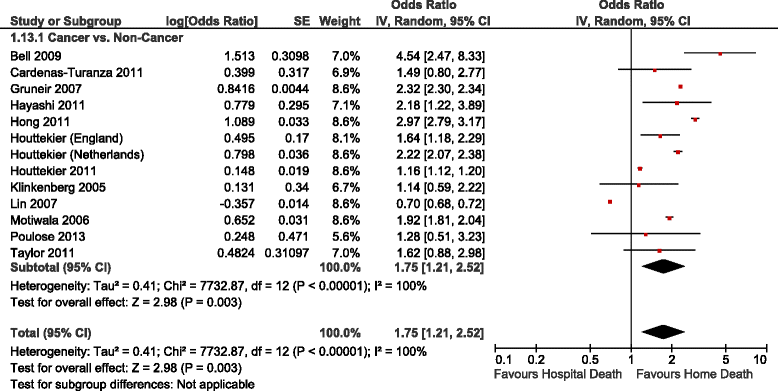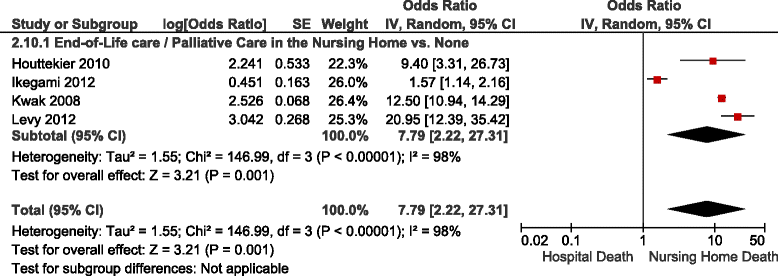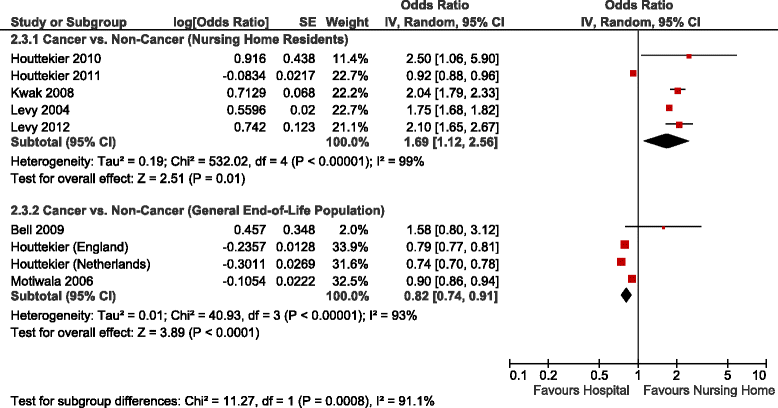The determinants of home and nursing home death: a systematic review and meta-analysis
- PMID: 26791258
- PMCID: PMC4721064
- DOI: 10.1186/s12904-016-0077-8
The determinants of home and nursing home death: a systematic review and meta-analysis
Abstract
Background: Most Canadians die in hospital, and yet, many express a preference to die at home. Place of death is the result of the interaction among sociodemographic, illness- and healthcare-related factors. Although home death is sometimes considered a potential indicator of end-of-life/palliative care quality, some determinants of place of death are more modifiable than others. The objective of this systematic review was to evaluate the determinants of home and nursing home death in adult patients diagnosed with an advanced, life-limiting illness.
Methods: A systematic literature search was performed for studies in English published from January 1, 2004 to September 24, 2013 that evaluated the determinants of home or nursing home death compared to hospital death in adult patients with an advanced, life-limiting condition. The adjusted odds ratios, relative risks, and 95% confidence intervals of each determinant were extracted from the studies. Meta-analyses were performed if appropriate. The quality of individual studies was assessed using the Newcastle-Ottawa scale and the body of evidence was assessed according to the GRADE Working Group criteria.
Results: Of the 5,900 citations identified, 26 retrospective cohort studies were eligible. The risk of bias in the studies identified was considered low. Factors associated with an increased likelihood of home versus hospital death included multidisciplinary home palliative care, preference for home death, cancer as opposed to other diagnoses, early referral to palliative care, not living alone, having a caregiver, and the caregiver's coping skills.
Conclusions: Knowledge about the determinants of place of death can be used to inform care planning between healthcare providers, patients and family members regarding the feasibility of dying in the preferred location and may help explain the incongruence between preferred and actual place of death. Modifiable factors such as early referral to palliative care, presence of a multidisciplinary home palliative care team were identified, which may be amenable to interventions that improve the likelihood of a patient dying in the preferred location. Place of death may not be a very good indicator of the quality of end-of-life/palliative care since it is determined by multiple factors and is therefore dependent on individual circumstances.
Figures







References
-
- Statistics Canada. Table 102–0509 - Deaths in hospital and elsewhere, Canada, provinces and territories, annual. In: CANSIM (database). 2013. http://www5.statcan.gc.ca/cansim/pick-choisir?lang=eng&p2=33&id=1020509. Accessed 24 Mar 2014.
-
- De Roo ML, Miccinesi G, Onwuteaka-Philipsen BD, Van Den Noortgate N, Van den Block L, Bonacchi A, et al. Actual and preferred place of death of home-dwelling patients in four European countries: making sense of quality indicators. PLoS One. 2014;9(4):e93762. doi: 10.1371/journal.pone.0093762. - DOI - PMC - PubMed
Publication types
MeSH terms
LinkOut - more resources
Full Text Sources
Other Literature Sources
Medical

